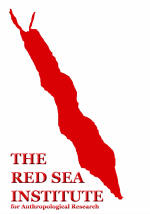The Red Sea Journal

The institute
is pleased to announce the creation of its journal for the study of the
Red Sea and surrounding regions. The journal will be peer reviewed and
published online beginning in 2017. We welcome submissions on the
anthropological fields--anthropology, archaeology, and ethnography, as
well as history when pertinent to the aforementioned disciplines.
Articles
Between Castrum and Medina: A Preliminary Note on Spatial Organisation and Urban Development in Medieval Aqaba.
By Kristoffer Damgaard
The
results of archaeological field work conducted between the 23rd of
January and the 6th of March 2008 at the Early Islamic site of Aylah,
located in Aqaba in southern Jordan. The excavations were part of a
larger international scientific venture known as the Islamic Aqaba
Project (henceforth IAP), which was directed by Prof. Dr. Johnny De
Meulemeester (University of Gent), and included an international staff
from Belgium, France, Spain, Canada, Jordan and Denmark. The project
grew out of the Belgian-British and later Belgian-French Aqaba Castle
Project (ACP), whose groundbreaking work revealed that the castle site,
and indeed Aqaba in general, had far more complex patterns of occupation
than hitherto imagined, and that a reevaluation of the area’s
settlement history was crucial. In order to establish a more
comprehensive occupational framework, steps were taken to expand the
scope of archaeological investigation to include the Early Islamic site
of Aylah as well. These are the results of the first season of field
work conducted here.
A Preliminary Report on a Coastal and Underwater Survey in the Area of Jeddah, Saudi Arabia.
By Ralph K. Pedersen
In
March 2012, Philipps-Universität Marburg conducted a 12-day survey
along a section of the Red Sea coast of Saudi Arabia reaching from
Rabigh in the north to al-Shoaiba in the south. As the beginning of a
five-year archaeological project, with the author as principal
investigator, this preliminary venture sought to define the logistical
situation and to discover any sites of archaeological importance that
may exist within the zone. The survey included the search for and the
examination of harbor sites, as well as shipwrecks. Sites of antiquity
and the Early Islamic period were of particular interest. The results of
the survey included the discovery of a harbor and a shipwreck of the
late third or the fourth century that contained Roman amphoras, among
other objects. This project was created by institute vice president Dr.
Rupert Brandmeier.

| pedersen_a_preliminary_report_on_a__coastal_and_underwater_survey_in_the_area_of_jeddah,_saudi_arabia.pdf |
Download File
The Byzantine-Aksumite Period Shipwreck at Black Assarca Island, Eritrea.
By Ralph K. Pedersen
In
1997, the author conducted an excavation of a shipwreck of late
antiquity off a desert island in the southern Red Sea. The wreck carried
a cargo of amphoras of three types, all of the kind now called "Aqaba
ware". The wreck is the oldest yet excavated in the Red Sea and has
yielded new insights into seafaring and trade of the period.

| pedersen_the_byzantine-aksumite_period_shipwreck_at_black_assarca_island,_eritrea.pdf |
Download File
Under the Erythraean Sea: An Ancient Shipwreck in Eritrea.
By Ralph K. Pedersen
An article from the INA Quarterly about the shipwreck at Black Assarca Island.

| pedersen_under_the_erythraean_sea_an_ancient_shipwreck_in_eritrea_inaq.pdf |
Download File
A Palestinian Red Sea Port on the Egyptian Road to Arabia: Early Islamic Aqaba and its Many Hinterlands.
By Kristoffer Damgaard
This
article argues that many forms of hinterland exist, and that it is
possible to formulate an analytical methodology based on tiered levels.
Examples could be 'political', in the sense of adminstrative affiliation
and/or subordinance to centres of political power, economic, in regard
to a site's position within relevant economic networks; or
ethnoconceptual, that is pertaining to the perceived identities of a
locality's occupants.

| a_palestinian_red_sea_port_on_the_egyptian_road_to_arabia.pdf |
Download File
Finding Fatimid Jordan: A Reinterpretation of Aylah's 'Fatimid Residence'.
By Kristoffer Damgaard
Fatimid
rule in Bilad al-Sham is relatively well understood in regard to major
events at important socio-political centres, however, ordinary life in
its more peripheral parts remains poorly documented and only
superficially examined. Southern Jordan, here defined as the area
between the Dead Sea and the Gulf of Aqaba, is one such region. In the
10th century CE this area was known as al-Sharat. While military control
over this area often depended on political circumstances elsewhere, it
remained important as both a transit corridor between the Fatimid
heartland in Egypt and the major urban centres of Syria-Palestine (e.g.
Damascus, Ramlah or Jerusalem), but also as a productive agricultural
region.3 Understanding the history of this region is thus highly
desirable, as it on one hand will help illuminate the impact of Fatimid
hegemony on local communities and, on the other, may assist in
explaining the dynamics between Fatimid, Saljuq, Frankish and local
political elites. Regrettably, relevant historical sources for Fatimid
South Jordan prior to the first Crusader incursions around 1100 CE are
scant, and this has led scholarship to perceive the region as culturally
and economically secondary to Egypt and Palestine.

| finding_fatimid_jordan_a_reinterpretation_of_aylahs_fatimid_residence.pdf |
Download File










 Stumble It!
Stumble It!

No comments:
Post a Comment